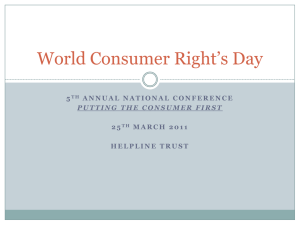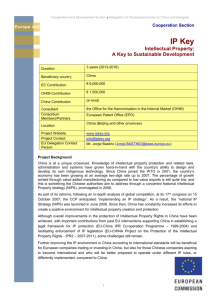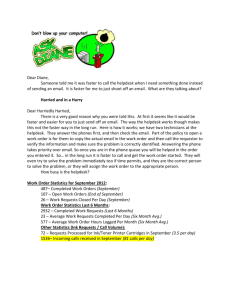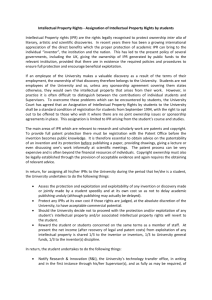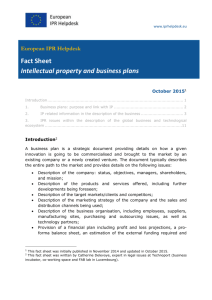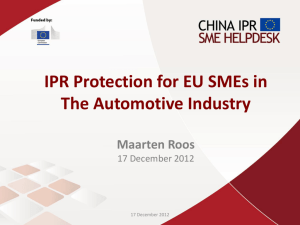Fact Sheet Intellectual Property considerations for
advertisement
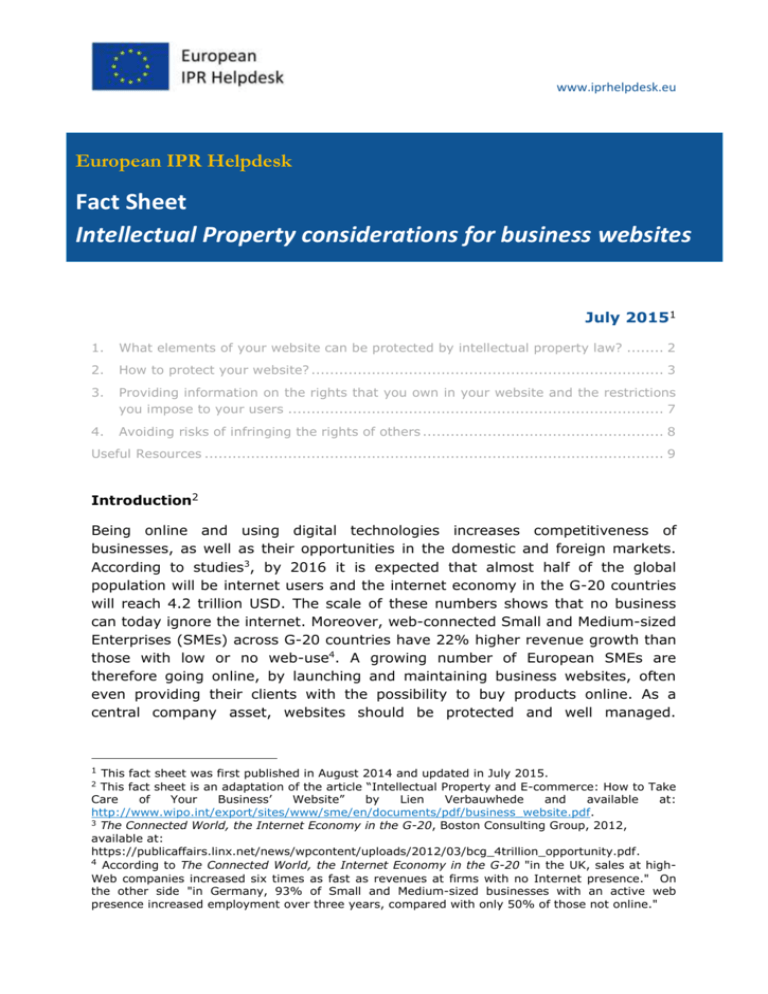
www.iprhelpdesk.eu European IPR Helpdesk Fact Sheet Intellectual Property considerations for business websites July 20151 1. What elements of your website can be protected by intellectual property law? ........ 2 2. How to protect your website? ............................................................................ 3 3. Providing information on the rights that you own in your website and the restrictions you impose to your users ................................................................................. 7 4. Avoiding risks of infringing the rights of others .................................................... 8 Useful Resources ................................................................................................... 9 Introduction2 Being online and using digital technologies increases competitiveness of businesses, as well as their opportunities in the domestic and foreign markets. According to studies3, by 2016 it is expected that almost half of the global population will be internet users and the internet economy in the G-20 countries will reach 4.2 trillion USD. The scale of these numbers shows that no business can today ignore the internet. Moreover, web-connected Small and Medium-sized Enterprises (SMEs) across G-20 countries have 22% higher revenue growth than those with low or no web-use4. A growing number of European SMEs are therefore going online, by launching and maintaining business websites, often even providing their clients with the possibility to buy products online. As a central company asset, websites should be protected and well managed. 1 This fact sheet was first published in August 2014 and updated in July 2015. This fact sheet is an adaptation of the article “Intellectual Property and E-commerce: How to Take Care of Your Business’ Website” by Lien Verbauwhede and available at: http://www.wipo.int/export/sites/www/sme/en/documents/pdf/business_website.pdf. 3 The Connected World, the Internet Economy in the G-20, Boston Consulting Group, 2012, available at: https://publicaffairs.linx.net/news/wpcontent/uploads/2012/03/bcg_4trillion_opportunity.pdf. 4 According to The Connected World, the Internet Economy in the G-20 "in the UK, sales at highWeb companies increased six times as fast as revenues at firms with no Internet presence." On the other side "in Germany, 93% of Small and Medium-sized businesses with an active web presence increased employment over three years, compared with only 50% of those not online." 2 The European IPR Helpdesk www.iprhelpdesk.eu Intellectual property is in this regard crucial, since there will be a number of intellectual property rights which exist in your website. This fact sheet aims to guide you through the most important steps which you should take to protect the website that you intend to launch or have already launched, and avoid the risks of infringing the rights of others. 1. What elements of your website can be protected by intellectual property law? Many parts of your website may be protected by different types of intellectual property (IP) rights in the European Union. For example: Technical innovations related to e-commerce systems, search engines or other technical Internet tools may be protected by patents or utility models; Software, including the text-based HTML code used in websites, can be protected by copyright, trade secrets and, if having a technical character, by patent as well; Your website design can be protected by copyright and elements such as computer-generated graphic symbols, screen displays and graphic user interfaces (GUIs) may be protected by designs; Most creative website content, such as written material, images, graphics, data and any music, broadcasts and videos, will be protected by copyright; Databases can be protected by copyright or by sui generis database laws; Business names, product names, logos, domain names and other signs posted on your website are likely to be protected by registered trade marks, as well as the law of passing off or unfair competition law depending on the jurisdictions; Hidden aspects of your website (such as confidential graphics, source and object code, algorithms, programs or other technical descriptions, data flow charts, logic flow charts, user manuals, data structures, and database contents) can be protected as confidential business information, as long as they are valuable, have not been disclosed to the public and you have taken reasonable steps to keep them in secrecy. 2 The European IPR Helpdesk www.iprhelpdesk.eu 2. How to protect your website? 2.1 Protecting your intellectual property 2.1.1 Choosing a business name, domain name and trade mark Selecting a domain name is a necessary step for the launch of your website. Domain names are human-friendly forms of Internet addresses and allow consumers to easily find your website in the internet. For example, the domain name of the European IPR Helpdesk is “iprhelpdesk.eu”. Domain names are However domain names are not registered through accredited registrars5. intellectual property rights and consequently do not give you any ownership rights over that name – the only right you acquire is the exclusive right to use that name for the duration of the licence period. Since domain names function in the internet as business names, very often they integrate the company name. If you intend to use your company name as the domain name of your business website, it is best practice to carefully select both at the same time and verify in advance if the one you intend to register is free to be used as a domain name, as well as a company name6. When you choose your company's domain name, it is also important to ensure that the name is distinctive and not descriptive. A distinctive domain name will not only allow your future clients to more easily remember your website, but also you to seek trade mark protection (see below). Company name Examples Eurice GmbH Domain name www.infeurope.lu infeurope S.A. Trade mark Eurice INFEUROPE Is it an IP right? No No Yes Where to request registration? With the competent national authority, which is often the authority responsible for the company’s incorporation With accredited registrars. With the national IP offices where you seek protection or at the Office for Harmonization in the Internal Market (OHIM). Requirements for registration? The requirements are established at national level. You should verify them with the registrar. - Is a sign that can be graphically represented - The sign is distinctive (not descriptive or generic) - The sign is not against public order or morality, nor goes against prior trade marks or rights of others To find accredited registrars we suggest you to consult the website of Internet Corporation for Assigned Names and Numbers (ICANN). 6 Domain names and company names are usually registered in different organisations and follow different national regulations. Hence, to verify if a given name is free as a domain name and company name you should contact each organisation responsible for the registrations. 5 3 The European IPR Helpdesk www.iprhelpdesk.eu Finally, when selecting the domain name also consider checking trade mark databases to verify if the name is free to be used as a trade mark7. This is a good practice not only to confirm that you can protect this name as a trade mark, but also because you want to avoid infringing the rights of other trade mark owners and potentially having to pay damages. Trade mark infringement: In the EU, a trade mark owner can prevent others from using signs that are identical or confusingly similar with its trade mark. 2.1.2 Seeking trade mark registration Trade marks are intellectual property rights which take the form of words, numbers, logos or any sign that distinguishes your goods or services from those of others in the market. Trade mark protection can be obtained by filing an application for registration within the territories that you select. In the European Union registration can be done in the National Intellectual Property Offices8 (NIPO) and, should you wish to have protection in several EU Member States, by seeking a Community trade mark registration at the Office for Harmonization in the Internal Market (OHIM). If your domain name can also be registered as a trade mark, then it is advisable to do so, since it strengthens your power to enforce your rights against anyone else who tries to use the name to market similar products and services, and prevents someone else from registering the same name as a trade mark. EXAMPLES: Word trade mark Logo INFEUROPE 000374496 0935753 2.1.3 Copyright Works such as text, images, photographs or software that you make available in your website are protected by copyright, as long as they are original, that is, they reflect the author’s creative ability and own “personal touch.” For details on trade mark searches, consult the fact sheet "How to search for trade marks", which is available in our online library. 8 To find information on the National Intellectual Property Offices in the European Union, consult the Innovaccess website at: http://www.innovaccess.eu/. 7 4 The European IPR Helpdesk www.iprhelpdesk.eu Even though copyright is an automatic right and registration is not a requirement for protection in the European Union, there are some tools available in order for your work to be recorded. Many companies, as well as some national offices, provide a “means of proof” of priority date, that is, that you have created a given text, photograph or software in a determined time9. Using such systems may prove to be useful, particularly when enforcing your rights against those trying to misappropriate your work. They provide you with evidence, essential in case of litigation. 2.1.4 Protecting designs Two-dimensional designs can be protected in the EU Member States through national registration at the NIPOs of the countries where protection is sought, but also by seeking a community design registration at the Office for Harmonization in the Internal Market (OHIM), which provides protection throughout the EU and for up to 25 years. However, the EU provides in addition protection through the Unregistered Community design, which protects designs for three years from the date that the design was first made public in the EU. Therefore, as soon as you make available your design in your website, you are automatically protected for three years, as long as the design qualifies for protection and is considered as new. Nevertheless, should you conclude that your design is valuable for your business and would prefer to seek in addition the protection under registered Community design, be aware that you have one year of grace period to fill in an application for registration. Indeed, you have one year after disclosure to seek registration without losing the novelty associated to your design10. Common designs related to websites include: - logos which you display on the website (example: application No. RCD 000754098-0001); - computer icons (example: application No. 000600184-0008); - web design (example: application No. 001100598-0009). 2.1.5 Avoiding disclosures of confidential information When developing your website it is likely that some valuable information is potentially shared with others, such as employees, website developers, maintenance contractors and IT providers, including website hosts. Examples of such tools are i-DEPOT, a service offered by the Benelux Office for Intellectual Property, and the SOLEAU envelope, provided by the French Patent and Trade Mark Office. Alternatively, creators may send themselves a copy of the original work by registered postal delivery, leaving the envelope sealed until when or if it is needed in an infringement action (in the UK this is commonly known as the “poor man‘s copyright”). It is also possible to lodge the work with a solicitor or notary. 10 For further details, check the article “Community Registered Design, the Grace Period and its Use by SME”, published in the European IPR Helpdesk Bulletin 14, available in our online library. 9 5 The European IPR Helpdesk www.iprhelpdesk.eu Information as such may only be protected if kept under secrecy, which gives your business a competitive advantage over its competitors. To maintain secrecy and still be able to develop, maintain and run your website, it is therefore necessary to establish confidentiality or non-disclosure agreements with those individuals and companies to whom you must share the confidential information11. 2.2 Making sure that your company owns the intellectual property in the work of its employees and subcontractors 2.2.1 Employees rights In the EU the ownership of intellectual property developed by employees is not generally harmonised. An important exception exists however in relation to software: software that is created by an employee in the execution of his duties or following the instructions given by his employer is owned by the employer12. However, in many EU Member States employers have, according to their national law, automatic ownership or at least the right to claim ownership on works other than software developed by their employees in the course of employment, such as text, images or inventions relating to your website. It is therefore best practice to be familiar with the national regulations in your country concerning the ownership of intellectual property over the work developed by your employees. 2.2.2 Subcontractors Small companies tend, however, to outsource the development and maintenance of their websites. Problems arise from the fact that it is often assumed that because the developer is being paid, the intellectual property rights in the resulting work belongs to the company who paid for it and not the developer. We must stress that in most countries independent contractors (contrary to employees) such as web developers usually own the intellectual property rights to their works, unless otherwise agreed in a written contract. Therefore, it is essential to consistently establish clear and written agreements with your independent web developers, defining in particular the ownership of the work to be developed. Failing to have such an agreement may put serious constraints to your company, particularly if you need to update your website, since you would generally not have enough rights to perform it without prior authorisation from the web developer. For information on Non-disclosure agreements, check our fact sheets “Confidential business information“ and “Non-disclosure agreement: a business tool“ available in our online library. 12 The employers and employees are free to agree differently by contract. 11 6 The European IPR Helpdesk www.iprhelpdesk.eu Most relevant clauses to include in a website development agreement: Scope of the work to be developed: define whether the developer will be responsible for writing only the computer code, or for the design and appearance as well. Clearly specify if he is responsible for the maintenance and updating of your website. Ownership of the work developed: Detail the ownership of each element of the website that will be developed under the contract. If you do not receive ownership rights (for example on the source code of the website), make sure that the agreement establishes that your company holds a licence. Confidentiality: Add in the agreement a clause bounding the web developer to confidentiality obligations, to make sure your company is protected against unauthorized disclosures. Warranties: To make sure you do not infringe rights of others when launching the website, consider introducing warranties from the web developer. 3. Providing information on the rights that you own in your website and the restrictions you impose to your users 3.1 What are your rights in the website content? Many internet users assume that material on websites can be freely used. Reminding viewers of your rights is therefore a good practice, helping you to prevent unintentional misappropriations of your website content. Thus, do indicate your website content is protected by copyright. You can do this by introducing a copyright notice: © [name of copyright owner] (first year of website launch – last year of updates). 3.2 Do you impose any restrictions on users? Should you want to allow users to be able to make some uses of your protected content, then it is best practice to clearly indicate them, which may be done on a particular webpage of the website which you dedicate to notices and disclaimers. For example, if your intention is to share the content of your website as a whole or some determined parts, such as determined images or graphics, you can select one of the Creative Commons licences13 available and make the content available under conditions. The Creative Commons licences are freely available copyright licences which provide you a ready-made way to “give the public permission to share and use your creative work — on conditions of your choice.“ Further information, is available in the website of Creative Commons: creativecommons.org. 13 7 The European IPR Helpdesk www.iprhelpdesk.eu If you use your website to advertise and sell your products, you should also remember that it is essential to provide for an agreement before your clients make the purchase. Commonly this is done through the introduction of terms and conditions, which must be clearly accepted before the purchase is concluded. Beware! In the EU there are regulations imposing information obligations to those advertising and selling on the internet which are common to all Member States. Do not forget that your own country may also impose further obligations on you. 4. Avoiding risks of infringing the rights of others Current technology makes it fairly easy to use material created by others, such as text, music, graphics or photographs on your website. The technical ease of using and copying these works does not give you the legal right to do so. Using material without getting permission - either by obtaining an assignment14 or a licence15 - can put your business on risk of infringements. Type of work What steps to take to avoid infringement? Technical tools (e.g. search engine) When using tools of others on your website, either free of charge or commercial, it is imperative to carefully verify the terms of the licence under which the owner of the tool makes it available to you, before accepting its terms and you start installation. Software It is likely that you will be using software of others when developing and maintaining your website. Irrespectively of having acquired the software through a download or store, whether it is proprietary software or open source, it is best practice to carefully read the terms of its licence, which will allow you to understand your legal obligations towards the software’s owner and any limitation with which you may have to comply. Copyright works (e.g text, photos, images, music) Works available on the internet are subject to copyright in the same way as works published through any other means. Hence, original works available on the internet are protected by copyright. Consequently, you are not allowed to copy and distribute it on your website. This is true not only if you just use the whole work (e.g. the whole website text of another company), but also when copying just a part that is considered To understand assignments, consult our fact sheet “Commercialising Intellectual Property: Assignment Agreement” available in our online library. 15 For detailed information on licences, consult our fact sheet “Commercialising Intellectual Property: Licence Agreement” available in our online library. 14 8 The European IPR Helpdesk www.iprhelpdesk.eu as substantial. Before using the work, it is therefore important to read the terms of use of the website where the work is published and request prior authorisation to the copyright owner. Naturally, this might be complex for some works, such as music, an extract of a film or book. For some works (mainly music, films and books) there are collective management organisations in your own country, where you can easily get an authorisation to use the work you need. Trade marks In few cases it is possible to use others’ trade marks. You may need it, for instance, if you intend to do comparative advertising within your website. In the European Union, EU Member States provide for regulation of such uses and therefore should you want to use a trade mark of your competitor when comparing your products, do become familiar with your national rules on comparative advertising and seek the assistance of a professional legal advisor. Designs (e.g. web design) The appearance of products, including online, can be protected through design. In the EU, protection is automatic for Unregistered Community design, but if registration of a Community design is sought, a stronger and longer protection is acquired. Hence, it is not because a given work is not registered as a design that it is not protected. Again, prior authorisation before using designs belonging to others is needed. Linking In the EU providing a clickable link to other websites or webpages (deep linking) publishing copyrighted material can be done without prior authorisation, when the websites or webpages are freely accessible. Circumventing restrictions implemented to restrict access to the works is, however, not admissible. Meta-tags Meta-tags are used in HTML to provide information on webpages. Since they are used to provide information making search engines more efficient, they are considered in the EU as a form of advertisement and therefore subject to the publicity regulations within the Member States. Problems arise with the use of trade marks of competitors as meta-tags, in order to increase the hits in websites. Useful Resources For further information please see: “Intellectual Property and E-commerce: How to Take Care of Your Business’ Website” by Lien Verbauwhede: http://www.wipo.int/export/sites/www/sme/en/documents/pdf/business_ website.pdf 9 The European IPR Helpdesk www.iprhelpdesk.eu GET IN TOUCH For comments, suggestions or further information, please contact European IPR Helpdesk c/o infeurope S.A. 62, rue Charles Martel L-2134, Luxembourg Email: service@iprhelpdesk.eu Phone: +352 25 22 33 - 333 Fax: +352 25 22 33 – 334 ©istockphoto.com/Dave White ABOUT THE EUROPEAN IPR HELPDESK The European IPR Helpdesk aims at raising awareness of Intellectual Property (IP) and Intellectual Property Rights (IPR) by providing information, direct advice and training on IP and IPR matters to current and potential participants of EU funded projects. In addition, the European IPR Helpdesk provides IP support to EU SMEs negotiating or concluding transnational partnership agreements, especially through the Enterprise Europe Network. All services provided are free of charge. Helpline: The Helpline service answers your IP queries within three working days. Please contact us via registration on our website – www.iprhelpdesk.eu – phone or fax. Website: On our website you can find extensive information and helpful documents on different aspects of IPR and IP management, especially with regard to specific IP questions in the context of EU funded programmes. Newsletter and Bulletin: Keep track of the latest news on IP and read expert articles and case studies by subscribing to our email newsletter and Bulletin. Training: We have designed a training catalogue consisting of nine different modules. If you are interested in planning a session with us, simply send us an email at training@iprhelpdesk.eu. DISCLAIMER This Fact Sheet has been initially developed under a previous edition of the European IPR Helpdesk (20112014). At that time the European IPR Helpdesk operated under a service contract with the European Commission. From 2015 the European IPR Helpdesk operates as a project receiving funding from the European Union’s Horizon 2020 research and innovation programme under Grant Agreement No 641474. It is managed by the European Commission’s Executive Agency for Small and Medium-sized Enterprises (EASME), with policy guidance provided by the European Commission’s Internal Market, Industry, Entrepreneurship and SMEs Directorate-General. Even though this Fact Sheet has been developed with the financial support of the EU, the positions expressed are those of the authors and do not necessarily reflect the official opinion of EASME or the European Commission. Neither EASME nor the European Commission nor any person acting on behalf of the EASME or the European Commission is responsible for the use which might be made of this information. Although the European IPR Helpdesk endeavours to deliver a high level service, no guarantee can be given on the correctness or completeness of the content of this Fact Sheet and neither the European Commission nor the European IPR Helpdesk consortium members are responsible or may be held accountable for any loss suffered as a result of reliance upon the content of this Fact Sheet. Our complete disclaimer is available at www.iprhelpdesk.eu. © European Union (2015) 10
